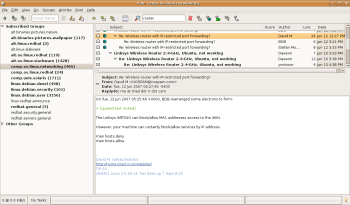Author: Anze Vidmar
If you still visit Usenet or occasionally participate in its discussions and newsgroups, you can get by with Linux newsgroup readers that are integrated into browsers or email clients such as Thunderbird, Evolution, and the Opera Web browser. But if you’re an advanced user who wants a more feature-rich newsreader, you need Pan.
Pan’s current stable release, 0.14.2, is four years old, but the project is in active development; its latest beta version is 0.131. You can download source and binary packages for Linux, Windows, and Mac OS X from the project’s site, and many distributions offer Pan in their repositories as well.
If you install from source, you need the pcre, gtk+, gtkspell, gnet, and libxml2 libraries installed on your system in order to successfully install and use Pan. Once they’re in place, extract the source tarball and use the familiar configure, make, make install process.
When you connect to your preferred news server for the first time, you’re provided with complete list of all newsgroups, and you can choose which to subscribe to. Pan supports multiple news servers, and servers that require NNTP authorization.
If you don’t subscribe to any newsgroups, when clicking on a newsgroup for the first time, Pan asks you how many article headers you wish to get. You have a choice of the last N days, all headers, all new headers, or the latest N headers.
Pan’s window is laid out in three panes — Groups, Headers, and Body — that can be positioned any way you like. By default, Pan displays a list of available or subscribed newsgroups on the left side of the window. When you select a newsgroup, the subjects of its articles are shown in the upper right pane. Click on a title, and Pan downloads and displays the article’s body in the lower pane.
Like any newsreader, Pan supports basic features like reading and writing messages, replying via email, and sorting articles by date, author, subject, or number of lines. You can view articles by thread, or search for specific words in subjects or article bodies. You can also cache articles so you can read them in offline mode.
Because it supports the yEnc encoding scheme for transferring binary files in text messages, Pan can display binary attachments such as images, video, and audio files in news posts. Pan also supports NZB, an XML-based file format that’s designed to be more bandwidth-efficient than other available formats for retrieving posts from NNTP servers.
You can filter articles in newsgroups to show only read or unread articles, cached, complete, articles you posted, and only watched articles. Watched articles are ones that you want to keep track of, and want to be notified when there are any new follow-up posts.
You can also filter out unwanted messages and spam with a bit of help from custom filters. To create a custom filter, first define a set of newsgroups to which the rule will apply. Next, define the field in an article that the rule will apply to, and the trigger action. In Figure 2, I’ve made a rule that will trigger when a word “Nudity” is found in the subject. When this word is found, the article will be ignored and will not be shown. In the last field you can define for how long you wish this rule to apply; the choices are next week, next month, or forever.
Unfortunately Pan does not provide you with advance spam filtering algorithms to identify spam postings. You must create and use your own set of rules for fighting spam.
Pan supports multiple simultaneous connections, so you can do more than one task at the same time. For example, you can download many binaries (pictures for example) while reading other articles. If you’re on low bandwidth, you can configure per-server maximum connections and session maximum connections.
You can also save connection time if you increase cache size and download the articles’ bodies for reading them later offline. Note that cache is limited to 10MB by default; if you’re planing to read news offline, you might want to increase the limit.
Pan comes with its own task manager that lets you see which tasks are running and manage them. You can manipulate tasks, such as by pausing binary downloads, reordering downloads, or canceling a specific task.
In summary, Pan offers some rich features that lightweight newsreader clients don’t have. Its simplicity and usability makes Pan suitable for all types of users.
Category:
- Internet & WWW



